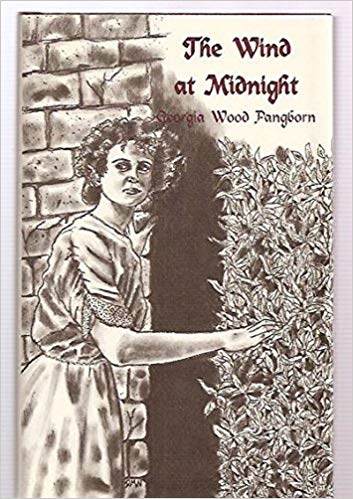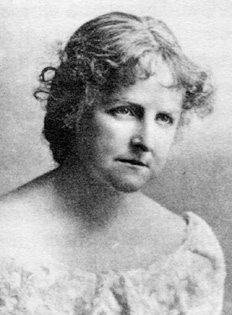One of the interesting things about the women who have historically written supernatural fiction, especially in America, is how little of their writing is available to those who want to read it. And one of the reasons so little of it is available is because most of them did not publish books. They wrote for newspapers and magazines– and, in fact, are sometimes referred to as “magazinists”. Newspapers and magazines are ephemeral in nature– here today and gone tomorrow– so a great deal of the work of women writers has simply vanished. In introducing her partial bibliography of Charlotte Perkins Gilman (unfortunately, no longer available online), who is widely known for penning the terrifying story “The Yellow Wallpaper”, Kim Wells noted that, as of 1998, just forty-three of her 186 stories had been published in book form. All of these appeared in magazines, and many of them appeared in The Forerunner, which she published herself. According to Wells, Gilman also wrote over a thousand pieces of nonfiction on a variety of topics, which were mostly published in magazines and newspapers (Oxford Online confirms this) and many of these have been inaccessible to researchers (although Radcliffe College reports that Harvard and Radcliffe now both have searchable collections of her papers in the process of digitization). And yet, most people know of this prolific writer and passionate social reformer primarily for one short story, “The Yellow Wallpaper” .
Even less is available on other women writers (particularly those who wrote between 1850 and 1930) whose works were published mainly in newspapers and magazines, and whose names we may not even know well enough to find. Unfortunately for most reader’s advisory librarians, even compilations in which the editor has gone to outstanding lengths to seek out works from women magazinists (and there are a limited number of these), are now out of print.
Georgia Wood Pangborn (1872-1958) is o ne of these women, well-known for her supernatural fiction during the time that she wrote, but now almost completely faded away. In a draft of an introduction to The Wind at Midnight, a limited edition collection of Pangborn’s short stories that was published in 1999, editor Jessica Amanda Salmonson wrote that “she was possibly the best American supernaturalist of her day. Yet she fell so far into obscurity after she withdrew from literary life in the middle of the 1920s, she has been totally unknown to modern anthologists of supernatural fiction.” Some of her works can be found online in PDF format, and a few reproductions of her books Roman Biznet and Interventions are now available through Amazon (although they are quite expensive and I don’t have any idea as to the content or quality at this time. If you would like to sample her work, one of her stories appears in What Did Miss Darrington See? An Anthology of Feminist Supernatural Fiction, edited by Jessica Amanda Salmonson, which is still in print.
ne of these women, well-known for her supernatural fiction during the time that she wrote, but now almost completely faded away. In a draft of an introduction to The Wind at Midnight, a limited edition collection of Pangborn’s short stories that was published in 1999, editor Jessica Amanda Salmonson wrote that “she was possibly the best American supernaturalist of her day. Yet she fell so far into obscurity after she withdrew from literary life in the middle of the 1920s, she has been totally unknown to modern anthologists of supernatural fiction.” Some of her works can be found online in PDF format, and a few reproductions of her books Roman Biznet and Interventions are now available through Amazon (although they are quite expensive and I don’t have any idea as to the content or quality at this time. If you would like to sample her work, one of her stories appears in What Did Miss Darrington See? An Anthology of Feminist Supernatural Fiction, edited by Jessica Amanda Salmonson, which is still in print.
 Sarah Wilkinson (1779-1831), also known as Sarah Scudgell Wilkinson or Sarah Scadgell, is primarily known for her blue books, or chapbooks, and in fact, her first short works were published in a literary magazine called The Tell-Tale Magazine, which published them simultaneously as chapbooks.
Sarah Wilkinson (1779-1831), also known as Sarah Scudgell Wilkinson or Sarah Scadgell, is primarily known for her blue books, or chapbooks, and in fact, her first short works were published in a literary magazine called The Tell-Tale Magazine, which published them simultaneously as chapbooks.
In a blog entry at The Gothic Imagination, Franz Potter gives some description of what exactly a chapbook or blue book was. These were heavily illustrated 36 to 72 page booklets, much shorter than the average Gothic novel. Potter writes that while Ann Radcliffe and her imitators moderated their use of terror, chapbook authors “filled their pages with continual scenes of horror”. Click here to see PDF images of the pages from one of the blue books Wilkinson wrote, The Castle Spectre (which was based on a play by Matthew Lewis), so you can see exactly what they look like.
This is what Sarah Wilkinson was best known for. Her writing wasn’t limited to chapbooks, however: in 1806, she published a subscription novel titled The Thatched Cottage; or, Sorrows of Eugenia, which had such eminent subscribers as the Duchess of Gloucester. From 1812-1819, she worked as a teacher and wrote primarily children’s stories and books, but returned to the Gothic after poor health forced her to resign her teaching position, publishing A Bandit of Florence (1819) and Lanmere Abbey (1820). Over the next decade, as her health continued to fail and her financial situation became desperate, she continued to write short pieces for periodicals and blue books. Potter has written about her in detail here.

1875 Elliott & Fry photograph,courtesy Jennifer Carnell, Sensation Press
Charlotte Riddell (1832-1906), also known as Mrs. J.H. Riddell and F.G. Trafford, was also a well-known writer of supernatural fiction. In an essay on her life, S.M. Ellis called her “a born story-teller”. In addition to producing numerous novels, she wrote a tremendous number of short stories and tales for a wide variety of publications. Ellis wrote that she had written so many that “she lost all count of her works, possessed very few copies of them herself, and often forgot where certain stories had appeared or what had happened to her rights in them.”She was born Charlotte Elizabeth Lawson Cowan. She grew up in Ireland, and many of her works are set there. Married in 1857 to Mr. Joseph Henry Riddell, she wrote primarily under the name Mrs. J.H. Riddell after that time. At her time, she was compared with Sheridan Le Fanu and her work was praised by M.R. James, a master of supernatural fiction himself. Peter Beresford Ellis quotes the critic James L. Campbell who wrote: “Next to Le Fanu, Riddell is the best writer of supernatural tales in the Victorian era” (note: if you click on the link above, you will have to scroll way down to find the artile on Riddell, but it is there). In addition to being a writer of popular supernatural fiction, Riddell also was part owner of the literary journal St. James’ Magazine. While Riddell has occasionally had stories appear in anthologies of supernatural fiction, her work has been out of print and often difficult to find in the past. There are some recent collections of her work that have been published, however, that include some of her better-known novels, novelettes, and short stories. These include The Collected Supernatural and Weird Fiction of Mrs. J. H. Riddell: Volume 1-Including Two Novels “The Haunted River, ” and “The Haunted House at Latchford; The Collected Supernatural and Weird Fiction of Mrs. J. H. Riddell: Volume 2-Including One Novel “The Nun’s Curse, ” and Two Short Stories; The Collected Supernatural and Weird Fiction of Mrs. J. H. Riddell: Volume 3-Including Two Novels “The Disappearance of Jeremiah Redworth, ” and “The Uninhabited House“
The Collected Supernatural and Weird Fiction of Mrs. J. H. Riddell: Volume 2-Including One Novel “The Nun’s Curse, ” and Two Short Stories; The Collected Supernatural and Weird Fiction of Mrs. J. H. Riddell: Volume 3-Including Two Novels “The Disappearance of Jeremiah Redworth, ” and “The Uninhabited House“
Or, perhaps if you don’t require an expensive three volume set, you might take a look at these smaller collections that look much more like something readers in search of a good ghost story might appreciate. Click on the cover images to find out more about the below titles:

 Weird Stories was first published in 1882, to great acclaim. Here’s a reasonably priced annotated version, currently in print.
Weird Stories was first published in 1882, to great acclaim. Here’s a reasonably priced annotated version, currently in print.

 Fourteen of Mrs. Riddell’s supernatural tales.
Fourteen of Mrs. Riddell’s supernatural tales.
These three women are just a few of those writing at the same time, struggling to make a living with their pens. All three of these women, writing as print culture exploded, made significant contributions to the writing of supernatural and Gothic fiction, the evolution of the ghost story, and the use of not just genteel terror, but of true creepiness and horror. Yet, while male authors of the same time are often well known, these women, as talented as they may have been, have been passed over by time. The scribbling women of the Romantic and Victorian eras, and well into the 20th century have a great deal to say, and it’s time to uncover it.

 ne of these women, well-known for her supernatural fiction during the time that she wrote, but now almost completely faded away. In a
ne of these women, well-known for her supernatural fiction during the time that she wrote, but now almost completely faded away. In a Sarah Wilkinson (1779-1831), also known as Sarah Scudgell Wilkinson or Sarah Scadgell, is primarily known for her blue books, or chapbooks, and in fact, her first short works were published in a literary magazine called The Tell-Tale Magazine, which published them simultaneously as chapbooks.
Sarah Wilkinson (1779-1831), also known as Sarah Scudgell Wilkinson or Sarah Scadgell, is primarily known for her blue books, or chapbooks, and in fact, her first short works were published in a literary magazine called The Tell-Tale Magazine, which published them simultaneously as chapbooks.





Follow Us!